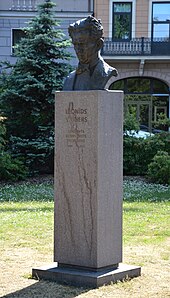Leonīds Vīgners
Leonīds Vīgners (born November 10, 1906 in Moscow , † December 23, 2001 in Riga ) was a Latvian composer, conductor and teacher.
Life
Leonīds Vīgners was the son of the conductor and composer Ernest Vīgners . In 1928 he graduated from the Riga Conservatory . He later studied in Switzerland with Felix von Weingartner in Basel . Between 1930 and 1939 he conducted the “Dziedonis” choir. From 1936 to 1944 he directed the Latvian National Opera . After that he was chief conductor of the opera and ballet theater until 1949 and at the same time, for two seasons, the artistic director of the Latvian Philharmonic Orchestra. From 1947 he taught at the conservatory. After its conversion to the Jāzeps Vītols Music Academy , he was professor there from 1961. In 1947 he founded the “Mūza” choir, which he directed for many years. From the 1950s to the 1970s he was - with one interruption - chief conductor of the Latvian radio orchestra. In addition, he led other important choirs in Latvia. In 1973 he conducted the world premiere of Imants Kalniņš's 4th symphony in Riga .
Leonīds Vīgners supported the Singing Revolution . At the 20th Latvian Song Festival , which was celebrated from June 30 to July 8, 1990, he conducted songs whose public performance had been banned since the occupation of Latvia by the Soviet Union.
Leonīds Vīgners was buried in the Riga Forest Cemetery. The Vīgners monument was erected in front of the Latvian National Opera in 2007 .
literature
- Vita Vēriņa: Leonīds Vīgners . In: Latvijas Zinātņu Akadēmija. Latvijas Zinātnu Akadēmijas vēstis. A daļa, Sociālās un humanitārās zinātnes , ISSN 0868-6556 , Vol. 50 (1996), Issue 1, pp. 80-88.
- Rūta Paula: Maestro Leonīda Vīgnera stāsti. Un stāsti par Leonīdu Vīgneru . Pētergailis, Riga 2001, ISBN 9984-673-81-2 .
Web links
- Leonīds Vīgners on timenote.info (Latvian)
Footnotes
- ↑ Guntis Šmidchens: The power of song. Nonviolent national culture in the Baltic singing revolution . University of Washington Press, Seattle 2014, ISBN 978-0-295-99310-2 , p. 205.
| personal data | |
|---|---|
| SURNAME | Vīgners, Leonīds |
| BRIEF DESCRIPTION | Latvian conductor, composer and educator |
| DATE OF BIRTH | November 10, 1906 |
| PLACE OF BIRTH | Moscow |
| DATE OF DEATH | December 23, 2001 |
| Place of death | Riga |
